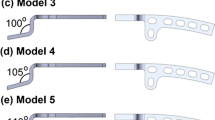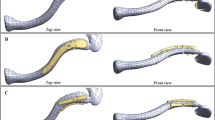Abstract
Purpose
Clavicle hook plates are frequently used in clinical orthopaedics to treat acromioclavicular joint dislocation. However, patients often exhibit acromion osteolysis and per-implant fracture after undergoing hook plate fixation. With the intent of avoiding future complications or fixation failure after clavicle hook plate fixation, we used finite element analysis (FEA) to investigate the biomechanics of clavicle hook plates of different materials and sizes when used in treating acromioclavicular joint dislocation.
Methods
Using finite element analysis, this study constructed a model comprising four parts: clavicle, acromion, clavicle hook plate and screws, and used the model to simulate implanting different types of clavicle hook plates in patients with acromioclavicular joint dislocation. Then, the biomechanics of stainless steel and titanium alloy clavicle hook plates containing either six or eight screw holes were investigated.
Results
The results indicated that using a longer clavicle hook plate decreased the stress value in the clavicle, and mitigated the force that clavicle hook plates exert on the acromion. Using a clavicle hook plate material characterized by a smaller Young’s modulus caused a slight increase in the stress on the clavicle. However, the external force the material imposed on the acromion was less than the force exerted on the clavicle.
Conclusions
The findings of this study can serve as a reference to help orthopaedic surgeons select clavicle hook plates.





Similar content being viewed by others
References
Beitzel K, Cote MP, Apostolakos J, Solovyova O, Judson CH, Ziegler CG, Edgar CM, Imhoff AB, Arciero RA, Mazzocca AD (2013) Current concepts in the treatment of acromioclavicular joint dislocations. Arthroscopy 29:387–397
Flinkkilä T, Ristiniemi J, Hyvönen P, Hämäläinen M (2002) Surgical treatment of unstable fractures of the distal clavicle: a comparative study of Kirschner wire and clavicular hook plate fixation. Acta Orthop 73:50–53
Lee YS, Lau MJ, Tseng YC, Chen WC, Kao HY, Wei JD (2009) Comparison of the efficacy of hook plate versus tension band wire in the treatment of unstable fractures of the distal clavicle. Int Orthop 33:1401–1405
Haidar SG, Krishnan KM, Deshmukh SC (2006) Hook plate fixation for type II fractures of the lateral end of the clavicle. J Shoulder Elbow Surg 15:419–423
Charity R, Haidar S, Ghosh S, Tillu A (2006) Fixation failure of the clavicular hook plate: a report of three cases. J Orthop Surg 14:333–335
Chiang CL, Yang SW, Tsai MY, Chen CKH (2010) Acromion osteolysis and fracture after hook plate fixation for acromioclavicular joint dislocation: a case report. J Shoulder Elbow Surg 19:e13–e15
Gu X, Cheng B, Sun J, Tao K (2014) Arthroscopic evaluation for omalgia patients undergoing the clavicular hook plate fixation of distal clavicle fractures. J Orthop Surg Res 9:46
Kashii M, Inui H, Yamamoto K (2006) Surgical treatment of distal clavicle fractures using the clavicular hook plate. Clin Orthop Rel Res 447:158–164
Renger R, Roukema G, Reurings J, Raams P, Font J, Verleisdonk E (2009) The clavicle hook plate for Neer type II lateral clavicle fractures. J Orthopc Trauma 23:570–574
Nadarajah R, Mahaluxmivala J, Amin A, Goodier D (2005) Clavicular hook–plate: complications of retaining the implant. Injury 36:681–683
Muramatsu K, Shigetomi M, Matsunaga T, Murata Y, Taguchi T (2007) Use of the AO hook-plate for treatment of unstable fractures of the distal clavicle. Arch Orthop Trauma Surg 127:191–194
Flinkkilä T, Ristiniemi J, Lakovaara M, Hyvönen P, Leppilahti J (2006) Hook-plate fixation of unstable lateral clavicle fractures: a report on 63 patients. Acta Orthop 77:644–649
Sanders R, Haidukewych GJ, Milne T, Dennis J, Latta LL (2002) Minimal versus maximal plate fixation techniques of the ulna: the biomechanical effect of number of screws and plate length. J Orthop Trauma 16:166–171
Rozbruch RS, Müller U, Gautier E, Ganz R (1998) The evolution of femoral shaft plating technique. Clin Orthop Rel Res 354:195–208
Huang HL, Tsai MT, Lin DJ, Chien CS, Hsu JT (2010) A new method to evaluate the elastic modulus of cortical bone by using a combined computed tomography and finite element approach. Comput Biol Med 40:464–468
Hsu JT, Fuh LJ, Lin DJ, Shen YW, Huang HL (2009) Bone strain and interfacial sliding analyses of platform switching and implant diameter on an immediately loaded implant: experimental and three-dimensional finite element analyses. J Periodontol 80:1125–1132
Hsu JT, Tsai MT, Chang CH, Fuh LJ, Lai KA, Liu ZL, Tu MG, Huang HL (2008) Finite element analysis of the effects of sizes of acetabular components on the initial stability of the acetabular cup. J Med Biol Eng 28:59–63
Su KC, Chuang SF, Ng EYK, Chang CH (2014) Evaluation of dentinal fluid flow behaviours: a fluid–structure interaction simulation. Comput Methods Biomech Biomed Eng 17:1716–1726
Su KC, Chuang SF, Ng EYK, Chang CH (2014) An investigation of dentinal fluid flow in dental pulp during food mastication: simulation of fluid–structure interaction. Biomech Model Mechan 13:527–535
Sakai R, Matsuura T, Tanaka K, Uchida K, Nakao M, Mabuchi K (2014) Comparison of internal fixations for distal clavicular fractures based on loading tests and finite element analyses. Sci World J 2014:817321
Cronskär M, Rasmussen J, Tinnsten M (2015) Combined finite element and multibody musculoskeletal investigation of a fractured clavicle with reconstruction plate. Comput Methods Biomech Biomed Eng 18:740–748
Chen DW, Lin CL, Hu CC, Wu JW, Lee MS (2012) Finite element analysis of different repair methods of Vancouver B1 periprosthetic fractures after total hip arthroplasty. Injury 43:1061–1065
Acknowledgments
The authors acknowledge the United States National Library of Medicine (NLM) and the Visible Human Project as the source of the image data used to create the finite element analysis model in this study. The first two authors (Cheng-Min Shih and Kui-Chou Huang) contributed equally to this work. The authors Kuo-Chih Su and Cheng-Hung Lee equally corresponded to this article.
Author information
Authors and Affiliations
Corresponding authors
Additional information
Cheng-Min Shih and Kui-Chou Huang contributed equally to this work.
Rights and permissions
About this article
Cite this article
Shih, CM., Huang, KC., Pan, CC. et al. Biomechanical analysis of acromioclavicular joint dislocation treated with clavicle hook plates in different lengths. International Orthopaedics (SICOT) 39, 2239–2244 (2015). https://doi.org/10.1007/s00264-015-2890-8
Received:
Accepted:
Published:
Issue Date:
DOI: https://doi.org/10.1007/s00264-015-2890-8




